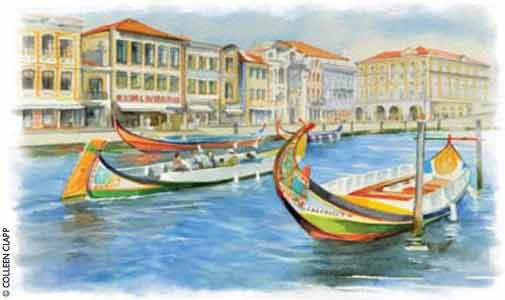The canal’s waters reflect the sun and soft light dapples the façade of a grand old mansion. I’m on a gondola-like boat gliding alongside cobbled slipways, lush parks, and ornate art nouveau townhouses, beating the crowds to an undiscovered European gem.
It may sound like Venice, but Aveiro, in central Portugal, is a smaller, more relaxed affair. No hordes of tourists here. With a population of around 78,000, Aveiro is an easy day trip by train, car, or bus from Lisbon—two hours away—and Porto—about an hour.
Curiosity brought me here on a relaxing overnight stay. Atmospheric cafés and restaurants ply their succulent wares on pavement terraces, as the sun glints off the city’s lagoon. A lunch of locally caught scabbard fish or grilled mackerel at a canal-side restaurant will cost you less than $15, including wine. Enjoy a coffee and delicious pastry to the sound of church bells and chattering starlings, and you’ll see change from $2.
If you do only one thing in Aveiro, though, make it a guided tour on a typical moliceiro boat.
These brightly painted craft are a lot like gondolas and were once used for the local trade in salt and seaweed.
A cruise of just under an hour takes you through Aveiro’s maritime past, its ornately tiled historic architecture, and its bustling fish market. Cruises leave from the central Rossio area every half-hour from mid-morning until dusk and cost less than $10. You may have time to sample the 15th-century Aveiro City Museum’s intricate splendor while you wait.
The city itself is no museum, though. You’ll find a vibrant community of students keeping things lively and a relaxed hospitality industry ensuring English-speaking guides and hotel staff year-round. It’s also worth noting that excellent surfing beaches are just a few miles west.
At the Vera Cruz grocery on decoratively cobbled Praça 14 de Julho, the staff roast coffee and dispense the regional specialty, ovos moles (rich, egg-based sweets), from dark wooden drawers more steam-age than information-era. Finding it? Just follow the smell of roasting coffee.

